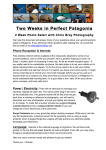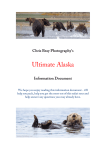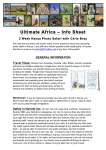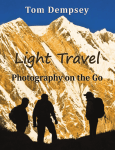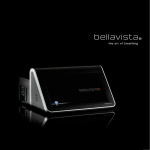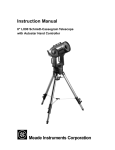Download Galapagps Safari
Transcript
Two Weeks in Galapagos 2 Week Photo Safari with Chris Bray We hope this document will answer many of your questions about your upcoming photo safari to the Galapagos Islands. If you still have further questions after reading this, of course feel free to email us at [email protected] at any time. Phone reception and Internet: There are many Internet cafes near the hotels that we stay at, and a lot of the restaurants, bars and cafes that we dine at in the evening have free Wi-Fi. As far as mobile reception goes – if you really need to be contactable via phone, the best option is to set your mobile up for global roaming before you depart. To do this all you need to do is call your mobile service provider and ask them to enable this before you leave your home country – it can be expensive to make & receive calls though! Just keep in mind that not all mobile phone providers will have coverage in the Galapagos Islands, for instance one of our previous safari attendees informed us that Optus don’t have a ‘global roaming’ arrangement with Ecuador. In this case you might want to purchase a ‘Travelsim ‘www.travelsim.net.au’. It might not be a bad idea to re-record your voice-mail message before you go too, just so if anyone does try to contact you, they know that your busy having fun in Galapagos! To avoid substantial data roaming fees, it’s a good idea to turn ‘data’ off on your phone when overseas. Power: There will be electricity to recharge your cameras, laptops etc each day. The mains power plug is the ‘US / Canadian’ style so you’ll be needing an adaptor. The general routine will be that once we get back from a day’s photographing you will want to download your new photographs, and put your laptop and camera on to charge before dinner. To make this a quicker process we suggest bringing a power board that has a surge protector so you can charge all of your electronics at the same time. Surge Protectors are a very good idea when traveling overseas. While we’ve not had any bad experiences in Galapagos or Ecuador, a blackout would not be surprising, and so using a surge protector when charging things like a laptop will help prevent any electricity spikes damaging your electronics. Emergency: Jess and I will carry a local mobile phone which will work from just about anywhere, and we are both wilderness trained first aiders and will carry an extensive first aid kit. Language: Spanish is the national language of Ecuador and thus on the Galapagos Islands as well. Most people on Galapagos Island will speak at least a little English, and most importantly our guides will speak English. Even still, you may enjoy bringing a small pocket phrase book to learn some local words. Here’s some common words and phrases to get you started: Thank you = Gracias Yes = Si No = No Hello = Hola Please = Por favor Medical information: Closer to departure we will email you a medical information form that we will ask you to fill in and email back to us. It’s not that Jess and I care what medication you take, but if you are involved in an accident and end up in hospital for some reason – we need this information on hand to give to the doctors. So please fill the medical form honestly and openly, with this in mind. Sea Sickness: There are a few boat trips involved with this safari, some up to around two hours long and in small boats – so if you know you get sea sick easily, then remember to pack some anti-sea-sickness tablets, ginger, pressure bands or whatever it is that you find works for you! (By the way, when I go sailing, I use ‘15mg Stugeron tablets’ which I buy online from Canada – seems to be the only stuff that works for me, and Jess uses transdermscop (scopolamine 1.5) patches – the benefit of these being you don’t loose the medication if you do become sick!). Don’t stress out though, as the seas are generally quite calm. Immunizations: There are several nasties that you will want to be immunised against in Galapagos. Obviously Jess and I are not doctors and so it’s best to consult your doctor and work out what immunizations are best for you, however after doing some research and discussing with our doctor, below is a starting point: • Hepatitis A injection - (last’s a life time) definitely worth getting! Many of you may already have this. • • • • A Tetanus injection - is also worth getting (they last about 10 years so check when you last had a booster shot), and in Australia the Tetanus shot is free and also contains a Dyptheria immuniser in the single injection! Yay – less needles! Diphtheria & pertussis vaccines can be added to the tetanus vaccine. Because many adults no longer have immunity from childhood vaccination, travellers to less developed countries are advised to have a tetanus, diphtheria & pertussis booster. Yellow Fever injection – while doctors do not seem to believe that this is needed for travelling in Galapagos, Australian Customs/Quarantine do require proof that you’ve been vaccinated before they welcome you home! You get a little yellow certificate that fits in your passport when you get this injection which you must bring with you. If you do not bring it, or if you are not immunised, Customs will still let you home, but you will be delayed while they explain to you how to report in should you develop symptoms. The injection lasts 10 years, costs about $55 and needs to be injected 2-3 weeks before you leave. The Y.F vaccine also seems to have the added bonus that it helps protect against melanoma skin cancers later in life – score! And just for the plane flights etc, it might not be a bad idea to have the latest influenza vaccine injection too – it’d be devastating if you were too sick to enjoy the experience just because you caught the flu on the way over! There is no malaria in the Galapagos Islands, but if you’re extending your holiday to explore the nearby Amazon etc, then you may well need such medication – check with your doctor. Travel Insurance: Chris Bray Photography will not be liable for any damage to your camera gear or equipment, nor your personal health or wellbeing. You MUST take out your own travellers insurance for these two weeks and email Jess your insurance policy once it has been confirmed. (Remember our travel agent Jacqui is very willing and able to help secure you the best deal here) Suggest things to bring: • • • • • • • • • • • Clothes (see detailed ‘clothing’ section below) Raincoat (just in case). Sturdy comfortable closed in walking shoes and a pair of sandals or thongs. Head torch/ torch Sunscreen Sunglasses (polarized will be best!) Lip moisturiser with Sunscreen i.e. Blistex Travel alarm clock (or iPhone!) Personal medication (if applicable) Camera backpack /daypack – something big enough to carry all your camera gear in and a rain jacket etc. Tripod – optional, good to bring it you wanted to do some light-painting on the beach. • • • • • • • • Happy snap camera (if you don’t have one and are looking at purchasing one – get an underwater one like a Canon D10 for snorkelling, or a GoPro camera for great underwater filming!!! If you are bringing a GoPro with you, and it is an older model (either Hero 1 or Hero 2) it is seriously worth investing in their specific underwater/dive housing – it has a flat glass port rather than curved, which results in much sharper images underwater.) Hero3’s come with this flat port as standard. Snap lock bags (for rainproofing camera gear) Spare camera batteries - Even though you will be able to re-charge your battery each night, it’s not a bad idea to carry a spare, in case there is a blackout and you can’t recharge, or, more likely, if you take so many photos some days that you’ll run out of your main battery mid-safari! Plenty of memory cards to store your awesome pictures on, perhaps even a portable hard-drive and laptop to back them up onto. Another option are ‘portable media storage devices’ that download from your card to its inbuilt hard drive automatically for you, however we do not recommend these devices as we have seen too many fail. You will enjoy having a laptop with you as it enables you to see (and learn from) your photos as you go. See ‘Memory Cards & Storage’ section. Your camera’s user manual – just in case even Jess and I really can’t work something out on your camera! Camera sensor cleaning equipment such as an airblower (optional – at your own risk – I can help and will have one of my own) And last but not least, don’t forget your camera and lenses (ideally with UV/lens protectors on the front of each), filters (polarizing filters might be great to have). Flashes are not allowed when photographing the wildlife so there isn’t much point in bringing a serious external flash unless you have the space! Don’t forget a little happy snap / compact camera too, if you have one! Swimmers, mask, snorkel, flippers & wetsuit/springsuit (if you can fit them in, else you can hire them there, but no guarantee on perfect sizing!). The humboldt Current sweeps deep cold water around these islands which brings a lot of the wildlife, but also means you’ll be chilly after 30min of swimming. Clothing: You will need some comfortable, lightweight ‘Safari clothes’ to allow for ease of mobility (to get down low for interesting shots, to climb in and out of boats etc). Pockets are useful for things like lens caps, lens cloths etc. Long-sleeves (and full-length pants) will help keep the sun off and are a great idea. You’ll find that your main clothes will be a couple of lightweight, loose pairs of full-length safari pants or shorts, and similarly loose, breathable tops. It would be ideal if these clothes were naturally earthy, pastel colours – we don’t want to frighten the animals! We recommend and wear “Craghoppers” they make great outdoor tops and pants with inbuilt permanent mosquito repellent, and are lightweight, durable, confortable and even fashionable in a variety of different colours. You can purchase Craghoppers from Anaconda and other outdoor stores. Don’t forget to bring a warm fleece, and a raincoat too. You might also want to bring something smart casual to wear for dinner on some nights when you’re sick of living in your safari gear and have enough time to change, but remember we’re here to see things, not be seen! =) Remember less is more! Think long and hard about what gear to take, as you don’t want to be lugging too much stuff around! The transfer boats have limited storage capacity & there are luggage limits on the domestic flights between Ecuador & the Galapagos islands that we’ll explain below! And last but not least, don’t forget a hat! Make sure it’s a wide-brimmed hat – and ideally without too stiff a brim (and certainly not a peaked baseball cap) as these stiff brims get in the way when you try and hold your camera up to your face. A drawcord on your hat is not a bad idea as it can get a bit windy on the boats! Galapagos islands are right on the Equator, and in November the average temperature is between 21-27degrees. So you should bring some warmer clothes and wet weather gear but don’t forget your summer shorts, t-shirt and swimmers. Washing: Don’t worry, you wont have to bring 14 shirts, and 14 pairs of undies!!! You can do washing, or have it done, at the various places we go to. On the main island we spend the first week at there are several very good, cheap Laundromats, and likewise in the other villages. Safety in Ecuador and Galapagos: In general, crime is not a problem at all in the Galapagos islands, there is little to be concerned about. Pre and post trip, you’ll need to take care when travelling in the main cities of Ecuador, especially in busy places like markets. Watch your camera very carefully, and always have it strapped around you. Don’t take chances – we have had a small compact camera stolen from a zipped jacket pocket! Checked in baggage: Apparently the general rule should be that (as much as possible), bring all your important stuff with you as carry-on luggage (this includes camera chargers etc – anything that would ruin your safari completely if it was stolen or if your main baggage was delayed etc. Unlikely of course, but it provides peace of mind if you carry your genuine ‘essentials’ with you). Money: The currency in Galapagos is US dollar. Most places will take credit card and there will be several ATM’s on the first island (that we spend a week at), but none on the second island, so stock up before leaving island #1! Its best to carry some cash on you for purchases like food, drinks and trinkets. Don’t for get to let your bank know that you will be overseas for two weeks – if your bank is unaware that your in Ecuador they might suspend your credit card the first time you try to use it, making it very hard to get any money out at all. Bags: Considering as we’ll be traveling around with our bags in boats from time to time between the different islands etc, it’s always best to bring your non-camera gear (clothes etc) in a soft bag such as a duffle-bag or backpack (with wheels might make it easier) - please don’t bring a suitcase, as they are awkward to stash away. You need to be comfortable carrying your own luggage on and off boats to our accommodation – so pack light! Luggage Restrictions! The airline that we fly to the Galapagos Islands (and back) have a 23kg check-in baggage limit that they are strict on. With carry-on luggage, you are allowed two bags, one weighing up to 10kg and a secondary smaller bag (like a women’s purse or laptop bag) that is not included in the 10kg weight limit. Last year when we travelled to Galapagos they didn’t weigh our carry-on bags but be prepared to put various lenses in your pockets and camera’s around our necks if they do start weighing them! =) Flights to Ecuador: Please contact Jacqui Smith <[email protected]>. She has been working with us for a few years now and knows the in’s and out’s of flying to Ecuador, she can also help you with flights, travel insurance, and any other side trips that you might want to do while in South America. The Safari starts in Guayaquil and we recommend that you fly in at least a day before it starts, it might even be worth considering flying in two days before it starts to give you self some time do to some sight seeing in Guayaquil – it’s really a great city to walk around with lots to see and do for a day! But that’s up to you and how much time you have allowed before and after the safari. If you do fly in a day earlier, the accommodation for that night and airport transfers are not included in the safari, so please email [email protected] and we can arrange your airport transfer and a hotel room for you at the Uni Park Hotel (where we stay and recommend that you also stay) at an additional cost. The safari finishes in Quito, Ecuador’s capital. Last year (2012), after the safari officially finished, we organized an additional day trip to the ‘cloud forest’ in the foothills of the Andes to photograph humming birds, waterfalls, orchids, insects, ferns and marvel at the spectacular views in the forest! It was a spectacular day and our whole group really loved it, saying that we should include it as part of the Galapagos Itinerary… well, we can’t find any days to take out from our Galapagos itinerary, so we thought we would offer it as an optional extra day after the tour. The Cloud Forest Day Trip (on the day that we’d normally drop you off at the airport in the morning) along with one night’s extra twin share accommodation for that night, with breakfast and airport transfers the next morning in Quito will cost $250 AU per/person. If you want to participate in the day trip (min. numbers do apply) breakfast will be included and a mini bus with an English Speaking driver will pick you up at 8am from the hotel lobby for the Cloud Forest Day Tour. It’ll take about an hour to get to the waterfall and orchid walk where you will be guided through this spectacular forest full of macro things to photograph, after that it’s about another hour+ to the cloud forest where you’ll be amazed at the verity and number of humming birds zipping around daring you to try and photograph them. Lunch (not included) will be at the Bellavista Cloud Forest Reserve Lodge in the middle of it all, and after, you’ll have the option to spend the afternoon getting that perfect shot of the humming birds or go for a guided walk through the forest and possibly spot a toucan and other amazing birds and animals! You’ll return from the day trip around 6pm and the evening is yours to either rest before the long flight back home, go out and enjoy some local Ecuadorian cuisine, or enjoy a meal at the hotel restaurant. Don’t want to do the additional day trip? No worries, you are free to fly back home or onward to some other holiday that day, as the itinerary indicates – we’ll of course still provide you with the airport transfers etc. Additional points for the Cloud forest day trip! - An additional $5US entry fee for the waterfall/orchid walk - The amazing lunch was about $25 US at the Bellavisa Lodge Wear a good pair of walking shoes, the forest can be very damp, slippery, wet and muddy, but the walks are not hard or steep. - Bring a raincoat! You’ll want to bring your macro lens if you have one for the flowers, ferns and insects, a telephoto lens for the humming birds, a wide angle for the waterfalls, views and scenery and possibly a tripod if you want to photograph the waterfalls. Chris and I likely not be attending this day trip but will be happy to give you advice, tips and pointers at how to best photograph the humming birds before you leave. Arriving in Ecuador: Remember to change the date and time on your camera, iPhone, etc. Other things to note: • • The exact order of the itinerary above may be shuffled around and tweaked due to weather, island control etc but you can rest assured that we'll be working flat-out to get you to all the best places, for the best photos possible. The accommodation we've selected in Galapagos is not luxury - it's perfectly functional and clean, every hotel room has a private ensuite, there's hot water, electricity, comfy beds, air conditioning and some even have wireless internet - but it's not the Ritz or the Hilton ok! However, we wont be spending much time in our rooms any way - just to sleep! Galapagos is an expensive place, and we have carefully selected our itinerary mainly to get you to the best photographic locations, with the best guides, at the best times - and not splurge on extravagant • • • • • • • • • • • • accommodation options instead!!! If you're concerned about this, let us know and we can organise superior accommodation for you at a (significant!) added cost. We will form our own private group - we will have our own guide, and all boat trips and inter-island taxis etc will be just us. If you need your mobile phone to work - be sure to enable global roaming before you go, there's great coverage, but be warned of global roaming fees, especially for data. Perhaps treat it as a much needed break from your hectic lives at home! You'll be able to access the internet from most of the hotels if you wish, and there's wireless internet in just about every restaurant. No meals are provided (except for the lunches when on a boat cruise), so all other meals and beverages must be purchased at your own expense. This frees you up to spend as much or as little as you wish on dinners etc at each venue. However, the average cost of a wonderful meal (even including a whole crayfish!) is between $10 and $20, and a beer less than $3. Accommodation arrangements vary for each location, however it is all twin-share. So, if you're booking on your own, then expect to share a room with someone else, and if you're booking as a couple, then we can organise a double bed rather than two singles - just let us know. For solo travellers we can't guarantee that we'll always be able to have you sharing with someone of the same sex - it depends on the gender split, but we do our best. You can request a single supplement (a room to yourself) just email Jess and she’ll let you know the extra costs. Keep in mind though that a) you're only usually in your rooms to sleep as we fill your waking hours with plenty to do, and b) the couple of times we have had clients get rooms for themselves, they end up regretting it when they see the amazing friendships that form between other roomies. Level of fitness - moderate? You do need to be able to get in and out of boats, and wander around for a morning or afternoon with your camera bag on your back. This is a remote island we're going to - there may be occasional power outages etc, but it's all part of the experience though, and I'm sure you'll survive. As with some Asian countries, some of the hotels ask that you don't put toilet paper down the loo, but in the bathroom bins instead, just for ecological reasons - please don't be offended. While the price DOES include the flight from Guayaquil airport in Ecuador to Galapagos, and the flight from Galapagos back to Quito airport in Ecuador, the price does NOT include flights from your home town to Ecuador, nor your return flight back home. However, flights from Sydney to Ecuador cost around $2,600 return. We have our own travel agent who is more than happy to help answer all your questions and help you find and book the best flights, travel insurance etc. If you have your own good quality snorkelling gear and can fit it in your luggage then do, however if not, fear not, as you can hire mask, snorkel and fins from the two islands at which we stay, for only about $5 a day =) We do not loan out our own camera equipment for this trip. We will bring a spare camera or two just in case but... be prepared to be self sufficient regarding your camera gear. All boat transfers, island entry fees and guides are included in the price. You MUST obtain your own travel insurance, but again, our travel agent can help you with this. There are national park rules that we must abide by, including not using flashes on - nor edging closer than 2m to - any wildlife (however you may find that the animals choose to come right up to you, and that's their decision! • • • • There are many boat trips on this safari, some several hours long, but the weather is generally not bad, and they are pleasant enough. Perhaps bring seasickness medication if you suffer this affliction though. The currency of Ecuador (and Galapagos) is the US dollar, so that's easy. If we do not reach minimum numbers, then we reserve the right to cancel the trip, and refund all the payments you make to us. The safari payments are split into three convenient instalments: A nonrefundable $1,000 deposit is required at time of booking to confirm your place, the next payment (also non refundable) of approx. 50% of what's owing will be requested around mid-year, and the final payment a couple of months before departure. This final payment IS refundable if you pull-out, unless you cancel within 45 days prior to departure in which case the money will not be returned to you, irrespective of if we manage to fill the spot later. This is why you must have travel insurance because unexpected things can happen and you don't want to be left out of pocket! Entry into the Galapagos Islands prohibits the importation of fresh fruit, plants or seeds, so keep this in mind when packing. CAMERA GEAR Where to begin…. What Lenses to bring: In an ideal world you’d want want a good wide angle zoom lens for landscape shots, a standard-ish zoom lens (wide-ish to zoomed-in-ish) for the ‘every day’ kind of shots, and a fairly serious telephoto lens (probably also a zoom) for all the wildlife shots. However, you DO NOT NEED TO GO AND SPEND A FORTUNE ON LENSES to get amazing photos! Even something like a twin lens kit (wide-to-normal, and normalto-telephoto) will cover your bases because we do get quite close to a lot of the animals, however, some animals are small (especially birds) and some are harder to get close to, so a good long telephoto lens up to say 300mm or ideally even 400mm will make the difference between a good photo and an amazing photo sometimes. So if you are thinking of buying one special lens for this trip, make it a telephoto zoom lens, and, if you’re tossing up between spending some $’s upgrading the body of your camera or buying a telephoto lens instead – buy the telephoto lens!!! I have written down a few suggested lenses below, the specs and the RRP – please note the RRP is from Digital Camera Warehouse – and prices do vary between different stores, so shop around. Also keep in mind that there is nothing wrong with getting a good second-hand lens from e-bay (assuming its in good condition!). If you have other creative lenses like macro lenses or fisheye lenses, bring them along as well, it’s always fun to have a play with different angles. Wide-angle Lenses - for Canon Cameras: Canon EF-S 10-22mm 1:3.5-4.5, RRP $899 (Great very wide lens for ‘sub-frame’ cameras – that’s basically any camera except the 1D series or the, 6D, 5D mk III or III !) Canon 17-40mm 1:4 L USM, RRP $939. Canon 16-35mm 1:2.8 L USM, RRP $1,929 (My favourite) Standard Lenses - You wont be using a standard lens that much, so to be honest, whatever came with your camera will probably be fine. But if you are in the market for an upgrade you really can’t go past the Canon 24-105mm USM IS L 1:4 – My favourite all-rounder / workhorse lens. Telephoto Lenses – Most of what we will be shooting will require a good long telephoto lens, the ideal focal length you would want to totally maximise your experience in Kenya is 400mm. However that’s not to say that you wont get awesome shots on most subjects even with a 300mm if that’s all you have. I’d hesitate against using anything shorter than 300mm though as your longest lens. The ideal wildlife lens that we recommend is: Canon 100-400mm EF 1:4.5-5.6 IS USM L, RRP (DCW) $1,989 You will be able to pick one of these beauties up for about $1,000 on e-bay at the moment, but they might not come with an Australian warranty. Or about $1,300 from non-Australian online retailer. But this lens will give you superbly sharp and zoomedin, big full-frame shots, and its image stabilisation its great. Remember the longer the lens, the more important it is to have image stabilisation. The other seriously long telephoto lens (which is a little cheaper than Canon’s 100400mm) is the Sigma 150-500mm 1:5-6.3 DG OS HSM, RRP $1,099. Now, this lens is great for those who can’t afford the Canon telephoto lens - it goes to a whopping 500mm, which is fantastic, but unfortunately it’s not as fast (not as small an f/#), the ‘OS’ (optical stabilization) does not work as well as on the Canon lens, and the images don’t tend to be quite as sharp. But yet, you get what you pay for, and this is certainly still a superb lens and great value for money Tele-extenders - Tele-extenders are affordable little ‘spacer lenses’ that go between your camera and your telephoto lens to make the lens longer – to ‘extend’ the focal length of your longest lens. You can get various sizes, but commonly you can get a 1.4x extender, or a 2x extender that will multiply the focal length of the attached lens by 1.4x and 2x respectively. So a 2x tele extender on a 100-400mm lens turns it into a 200-800mm epic lens! However, there is a catch. 1. You may loose a little image clarity, 2. You won’t be able to scroll down to such small f/#’s anymore as tele extenders ‘reduce the maximum effective aperture’ of the lens, and, 3. You may LOOSE THE ABILITY TO AUTOFOCUS your lens! You've got to be very careful with tele-extenders and Auto-Focus (AF). My understanding is: For AF to work, the 'max effective aperture' of the lens & extender combined must be at least f/5.6 (or a slightly more tolerant f/8 for pro 1D series cameras). The 2x tele extender reduces the max effective aperture by '2 stops' (F# scale increasing by 1 stop at a time goes like this: f/1.4, f/2, f/2.8, f/4, f/5.6, f/8) So for the 2x tele to work on a normal camera, the lens you’re attaching it to would need to be a f/2.8 lens or faster (ie, bloody fast & expensive), but the 1.4x tele extender only reduces the f-stop by 1 stop, so you could get AF with a lens f/4 or faster (as it will ‘become’ an f/5.6 or faster). SO – I usually recommend people if they want a teleextender to go for the 1.4x tele, else many of your lenses won't AF anymore (unless you have a damn expensive fast lens), which can be a big pain. You DON’T NEED a tele-extender for the Kenya trip, but it is a good tool to pull out to give you that little bit more reach sometimes. Keep in mind that you can always borrow camera equipment from hire places in Australia – so if you’re not interested in purchasing your own, perhaps look into how much it would cost to hire. Remember though that if your longest telephoto lens is only an f/5.6 lens, then even if you just use a 1.4x tele, you still wont be able to AF (not that manual focus is impossible to use, it just slows you down a lot!) Camera Body: Again, it’s more important to have a good telephoto lens than a brand new camera body, however if you are looking to upgrade your camera body, here are some simple guides. If you don’t own a camera yet, and are only looking at an entry level camera, then the Canon 650D or 60D are great (and record HD video too, as do the others we will now look at!). Looking at the mid-range ‘enthusiast’ level cameras which the majority of safari travellers will be using, currently I’d say the best ones to look at in increasing order of price and awesomeness are the Canon EOS 60D, then the 7D. Up from there you get into full-frame cameras including the 6D and the 5D mk III, both amazing cameras – but realise that with a full-frame camera your lenses don’t seem as zoomed in: Sub frame cameras make your lenses seem about 1.6x more zoomed in which can be great for wildlife, so don’t fall for the trap of thinking that a full-frame is always going to be better for you. Think long and hard between a 5D mk II and a 7D – I’d go the 7D for various reasons (the fact it’s not full-frame is actually a good thing for wildlife shooting, as we just said), the 7D also has an in built flash, can take up to 8 pics/sec in burst mode (for when the sea-eagle swoops and snatches up the fish from the lake!) compared to 3.9 pics/sec of the 5D mk II etc. The 5D mk III though blows the 7D out of the water. After the 7D/6D,5D’s, well, if you want to step into the professional range of cameras, then you’re looking at the Canon 1D mk IV or a 1D X. If you are looking at up-grading your canon body, feel free to shoot us an email at [email protected] and we can help you out. Remember that Jess and I don’t make a cut out of what you end up purchasing, or have stock we’re tying to sell-off, unlike the guys at some camera stores . Bringing Multiple Cameras: If you happen to have two cameras (don’t worry if you don’t, it’s kinda a bit excessive!), some people find it great to bring them both, with a long lens attached to one, and a wide lens attached to the other – this means that you don’t have to change lenses so much, it’s faster, and also provides redundancy/backup should your camera fail. (Unlikely – and we’ll bring a few spare Canon 600D’s with us just in case any of your cameras do die). If you have a little compact ‘point-and-shoot’ camera for your pocket, that might come in handy too! Again, if you only have one camera that’s totally fine! Memory Cards & File Storage: While you should certainly be practicing restraint and only taking photos that are worth taking, you’ll still need LOTS of memory cards and it might also be a great idea to bring some kind of data backup system. A laptop with an external hard drive is good, as with the laptop you have the big advantage that you can look at your photos each night, see how they turned out, and even learn from them, but has the disadvantage of being heavy and delicate to bring, and just one more thing to keep charged! Another option is using a ‘portable media storage device’ like a ‘Wolverine PicPac II – 320 GB Digital Camera Backup System’ that is basically a hard drive and a cardreader built into one, that just sucks off the photos from your card onto it’s inbuilt hard drive, without the need for a laptop. These are cool, however you can’t see your photos very well, and not at all on some of them, and you will want to learn how they work before you leave! Some people simply opt to bring enough spare memory cards that they don’t even need to copy them onto anything – you’ll just have to get good (and ruthless) about deleting your less-good photos every evening, just by peering at them on the back of your camera – which is hard! As a ballpark figure, you will need anywhere from 50GB to 100 GB of storage space for the two weeks, assuming you’re shooting in highest quality JPEG mode. If you’re shooting in RAW mode, or additionally shooting large amounts of HD video, then you might need more storage, perhaps up to a whopping 500GB if you’re totally crazy. To avoid the risk of loosing your images if a memory card fails or something, you should try to always keep two copies of your photographs. For example I use a laptop and two identical external hard drives, and each evening I download my photos onto the first one drive, then copy them additionally to the second one, before deleting/formatting the memory card - just in case! Underwater Compact Camera: We get the opportunity to do a lot of snorkelling, and you’ll really enjoy the ability to get some shots of all the sea life – turtles etc – so this might be a good idea. Something like a Canon D10 is great, or even a GoPro camera for getting some great underwater HD footage! Dust & Camera Gear: Changing lens out on safari can be a challenge – there can be a lot of dust – and it will always try to get inside your camera and land on your image sensor (resulting in little black spots on your photos). Perhaps invest in a ‘Rocket blower’ (hand-held air puffer) to carefully blow any such dust off your sensor (but of course you only attempt this in a nice clean room). About the Galapagos Islands (From Wikipedia) The Galápagos Islands are an archipelago of volcanic islands distributed around the equator in the Pacific Ocean, 972 km (525 nmi) west of continental Ecuador, of which they are a part. Wildlife is its most notable feature. The Galápagos Islands and its surrounding waters form an Ecuadorian province, a national park, and a biological marine reserve. The principal language on the islands is Spanish. The islands have a population of around 23,000. The islands are geologically young and famed for their vast number of endemic species, which were studied by Charles Darwin during the voyage of the Beagle. His observations and collections contributed to the inception of Darwin's theory of evolution by natural selection. The first crude navigation chart of the islands was done by the buccaneer Ambrose Cowley in 1684. He named the individual islands after some of his fellow pirates or after the English noblemen who helped the privateer's cause. More recently, the Ecuadorian government gave most of the islands Spanish names. While the Spanish names are official, many users (especially ecological researchers) continue to use the older English names, particularly as those were the names used when Charles Darwin visited. Other questions? If you’ve any burning questions or uncertainties, please just let us know. Cheerio, Chris & Jess www.ChrisBray.net [email protected] Mobile: +61-(0)402-839-929














